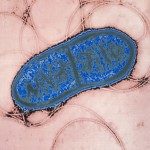Link to Pubmed [PMID] – 27060147
Nucleic Acids Res. 2016 Apr;
The RNA-guided Cas9 nuclease from CRISPR-Cas systems has emerged as a powerful biotechnological tool. The specificity of Cas9 can be reprogrammed to cleave desired sequences in a cell’s chromosome simply by changing the sequence of a small guide RNA. Unlike in most eukaryotes, Cas9 cleavage in the chromosome of bacteria has been reported to kill the cell. However, the mechanism of cell death remains to be investigated. Bacteria mainly rely on homologous recombination (HR) with sister chromosomes to repair double strand breaks. Here, we show that the simultaneous cleavage of all copies of theEscherichia colichromosome at the same position cannot be repaired, leading to cell death. However, inefficient cleavage can be tolerated through continuous repair by the HR pathway. In order to kill cells reliably, HR can be blocked using the Mu phage Gam protein. Finally, the introduction of the non-homologous end joining (NHEJ) pathway fromMycobacterium tuberculosiswas not able to rescue the cells from Cas9-mediated killing, but did introduce small deletions at a low frequency. This work provides a better understanding of the consequences of Cas9 cleavage in bacterial chromosomes which will be instrumental in the development of future CRISPR tools.


